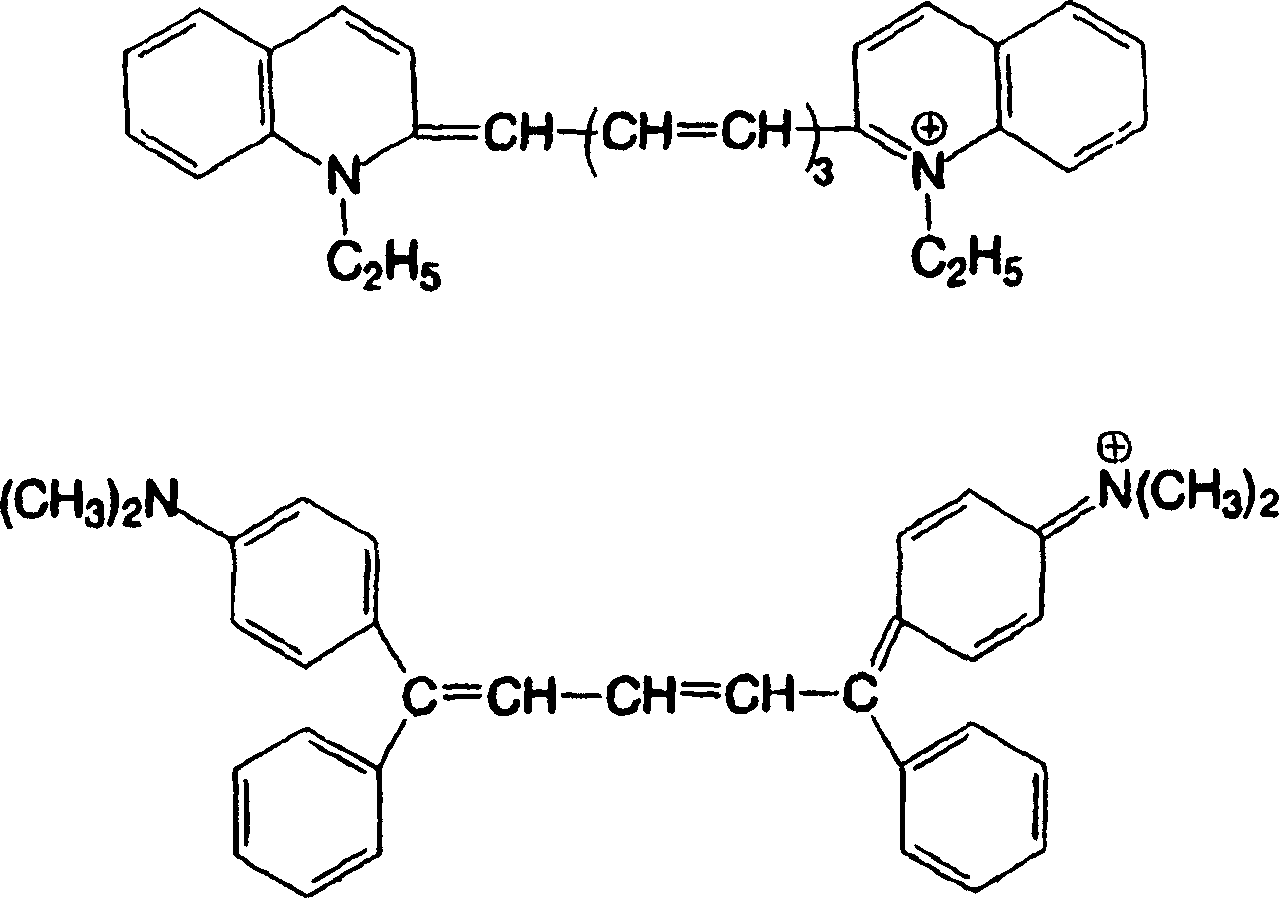Negative photosensitive composition and negative photosensitive lithographic printing plate
A negative photosensitive and composition technology, which is applied in the field used in China, can solve the problems of insufficient intensity of image parts, decreased sensitivity, and decreased sensitivity, and achieves the effects of excellent storage stability and high sensitivity.
- Summary
- Abstract
- Description
- Claims
- Application Information
AI Technical Summary
Problems solved by technology
Method used
Image
Examples
Embodiment 1
[0169] As shown in the compounding table of Table 1, 0.3 g (3% by weight) of a near-infrared-absorbing cationic dye (A-1) represented by the following formula (A-1) (manufactured by Showa Denko, IRB) was used as (A) Infrared absorber; 0.6g (6% by weight) organoboron compound (B-1) represented by the following formula (B-1) (manufactured by Showa Denko, P3B) as (B) organoboron compound; 0.9g (9% by weight %) the salt (C-1) (manufactured by Wako Pure Chemical Industries) shown in the above-mentioned formula (6) as (C) salt; (D) A compound having a polymerizable unsaturated group; 4.7 g (47% by weight) of the above-mentioned acrylic resin (E-1) of an alkali-soluble resin as (E) a binder resin; 0.2 g of DC-190 ( 10% ethylene glycol monomethyl ether solution, manufactured by ィーストマンコテックカンパニニ) as a surfactant; 0.3 g of D-11 (manufactured by PCAS) as a coloring material, and the above-mentioned substances were dissolved in a solution containing 70.0 g of ethylene glycol monomethyl...
Embodiment 2~10、 comparative example 1~3
[0179] A negative photosensitive lithographic printing plate was produced and evaluated in the same manner as in Example 1, except that the composition of the coating liquid was changed to that shown in Table 1. The evaluation results are shown in Table 2. Here, the near-infrared-absorbing cationic dye (A-2) in Table 1 is a substance represented by the following formula (A-2) (manufactured by Eastman Chemical Co., Ltd.), and the near-infrared-absorbing cationic dye (A-3) is The substance represented by the following formula (A-3) (manufactured by Showa Denko, IRT), the organoboron compound (B-2) is the substance represented by the following formula (B-2) (manufactured by Showa Denko, NP3B), The salt (C-2) is a substance represented by the above formula (7), the salt (C-3) is a substance represented by the following formula (C-3) (manufactured by Wako Pure Chemical Industries), and the salt (C-4) is The substance represented by the following formula (C-4) (manufactured b...
Embodiment 11~19、 comparative example 4~5
[0204] A negative photosensitive lithographic printing plate was produced and evaluated in the same manner as in Example 1, except that the composition of the coating solution was changed to that shown in Table 3. The evaluation results are shown in Table 4. Here, the near-infrared-absorbing cationic dye (A-2) in Table 3 is the same as that used in Comparative Example 3, and the salts (C-1) to (C-3) are the same as those used in Examples 1 to 6. Similarly, salts (C-9) to (C-11) are the ones shown below (manufactured by Wako Pure Chemical Industries), and the acrylic resin (E-3) is allyl methacrylate / methacrylic acid copolymer (manufactured by Gifu Shellac Co., Ltd.), and the polymerization initiator was the same as that used in Comparative Example 2.
[0205] negative photosensitive composition
[0206] [chem 25]
[0207] Salt (C-9)
[0208]
[0209] [chem 26]
[0210] Salt (C-10)
[0211]
[0212] [chem 27]
[0213] Salt (C-11)
[0214]
[021...
PUM
| Property | Measurement | Unit |
|---|---|---|
| boiling point | aaaaa | aaaaa |
Abstract
Description
Claims
Application Information
 Login to View More
Login to View More - R&D
- Intellectual Property
- Life Sciences
- Materials
- Tech Scout
- Unparalleled Data Quality
- Higher Quality Content
- 60% Fewer Hallucinations
Browse by: Latest US Patents, China's latest patents, Technical Efficacy Thesaurus, Application Domain, Technology Topic, Popular Technical Reports.
© 2025 PatSnap. All rights reserved.Legal|Privacy policy|Modern Slavery Act Transparency Statement|Sitemap|About US| Contact US: help@patsnap.com



